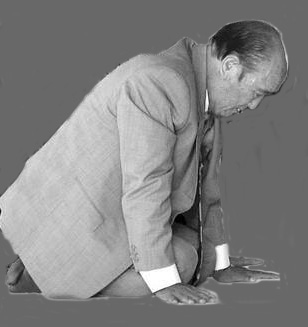The Richard Urban Show:
#83-Was the US Capitol Breach Part of a False Flag Operation?
#82-Mike Pence Is Judas Iscariot
2 Corinthians 7
13 And we were greatly encouraged.
Although we were encouraged, we felt even better when we saw how happy Titus was, because you had shown that he had nothing to worry about. 14 We had told him how much we thought of you, and you did not disappoint us. Just as we have always told you the truth, so everything we told him about you has also proved to be true. 15 Titus loves all of you very much, especially when he remembers how you obeyed him and how you trembled with fear when you welcomed him. 16 It makes me really glad to know that I can depend on you.
Ezekiel 21
18 The Lord said:
19 Ezekiel, son of man, mark two roads for the king of Babylonia to follow when he comes with his sword. The roads will begin at the same place, but be sure to put up a signpost where the two roads separate and go in different directions. 20 Clearly mark where the two roads lead. One goes to Rabbah, the capital of Ammon, and the other goes to Jerusalem, the fortified capital of Judah. 21 When the Babylonian king stands at that signpost, he will decide which way to go by shaking his arrows, by asking his idols, and by carefully looking at the liver of a sacrificed animal.22 His right hand will pull out the arrow marked “Jerusalem.” Then he will immediately give the signal to shout the battle cry, to build dirt ramps to the top of the city walls, to break down its walls and gates with large wooden poles, and to kill the people. 23 Everyone in Jerusalem had promised to be loyal to Babylonia, and so none of them will believe that this could happen to them. But Babylonia’s king will remind them of their sinful ways and warn them of their coming captivity.
Richard: When Israel did not honor God, and the people sold out to the Babylonian ruler and thought they were safe, they were judged anyway.
Suffering
The first of the Buddha’s four noble truths is that human existence is suffering (pali dukkha). suffering is the pervasive human condition, a sort of illness generated by the self through its false attachments. Buddhist texts—echoed in other scriptures—describe it by the metaphor of a universal fire engulfing the world. in Hinduism, the human lot is to go through an endless cycle of death and rebirth, conditioned by the results of past actions. Ecclesiastes is in many ways the most Buddhist of books in the bible in its theme of the vanity of human works. Few are those who ever fulfill all their desires, yet even those who do are not satisfied, ever wanting more. akin to this is the observation in Chinese texts that even when people begin with the best of intentions, their behavior usually degenerates and ends in acrimony, betrayal, or violence.in Christianity, the doctrine of original sin conveys a similar idea: by their fallen condition people are unable to fulfill their life’s purpose. Father Moon often laments about the interminable misery of the human condition and explains how the human Fall brought this about.
- Sorrow Is Everywhere
The Noble Truth of Suffering (Dukkha) is this: Birth is suffering; aging is suffering; sick-ness is suffering; death is suffering; sorrow and lamentation, pain, grief, and despair are suffering; association with the unpleasant is suffering; dissociation from the pleasant is suffer-ing; not to get what one wants is suffering—in brief, the five aggregates of attachment are suffering.
Samyutta Nikaya 56.11 (Buddhism)
Affliction does not come from the dust,
nor does trouble sprout from the ground;
but man is born to trouble
as the sparks fly upward.
Job 5.6-7
This world, become ablaze, by touch of sense afflicted,
utters its own lament. Whatever conceit one has,
therein is instability. Becoming other,
bound to becoming, yet in becoming it rejoices.
Delight therein is fear, and what it fears is Ill.
Udana 32 (Buddhism)
Brothers, all is burning. And what is the all that is burning? Brothers, the eye is burning, visible forms are burning, visual consciousness is burning, visual impression is burning, also whatever sensation, pleasant or painful or neither-painful-nor-pleasant, arises on account of the visual impression, that too is burning. Burning with what? Burning with the fire of lust, with the fire of hate, with the fire of delusion; I say it is burning with birth, aging, and death, with sorrows, with lamentations, with pains, with griefs, with despairs.
The ear is burning, sounds are burning, auditory consciousness is burning… Burning with what? Burning with the fire of lust, with the fire of hate, with the fire of delusion; I say it is burning with birth, aging, and death, with sorrows, with lamentations, with pains, with
griefs, with despairs.
The nose is burning, odors are burning…
The tongue is burning, flavors are burning…
The body is burning, tangible things are burning, tactile consciousness is burning…
The mind is burning, thoughts are burning…
Burning with what? Burning with the fire of lust, with the fire of hate, with the fire of delusion; I say it is burning with birth, aging, and death, with sorrows, with lamentations, with pains, with griefs, with despairs.
Samyutta Nikaya 35.28: The Fire Sermon (Buddhism)
Farid, I thought I alone had sorrow;
Sorrow is spread all over the whole world.
From my roof-top I saw
Every home engulfed in sorrow’s flames.
Adi Granth, Shalok, Farid, p. 1382 (Sikhism)
